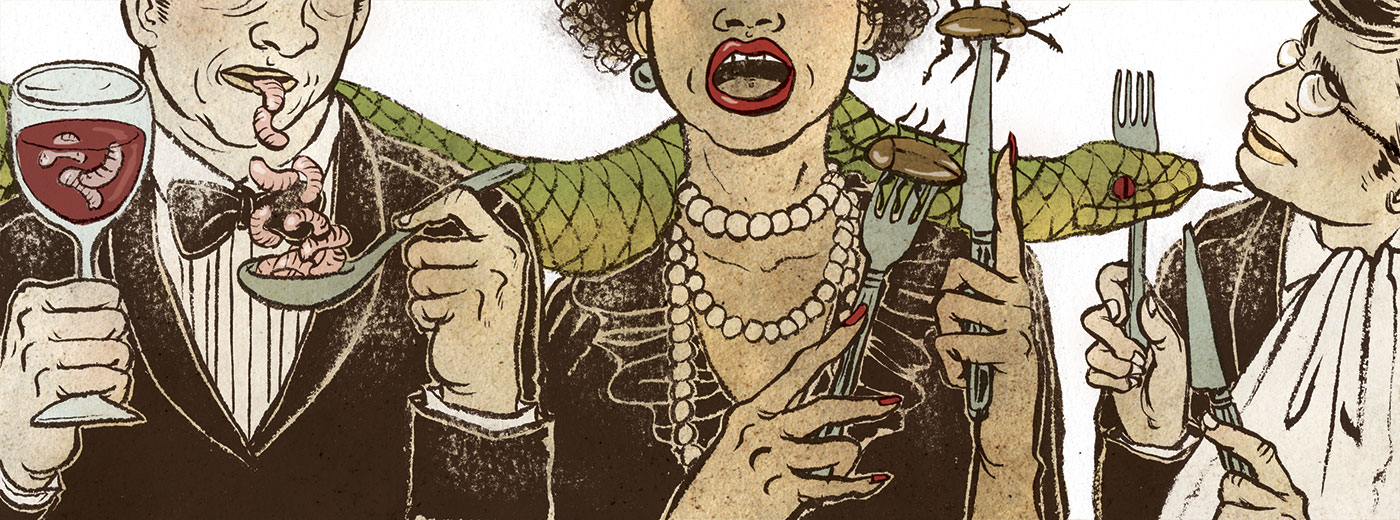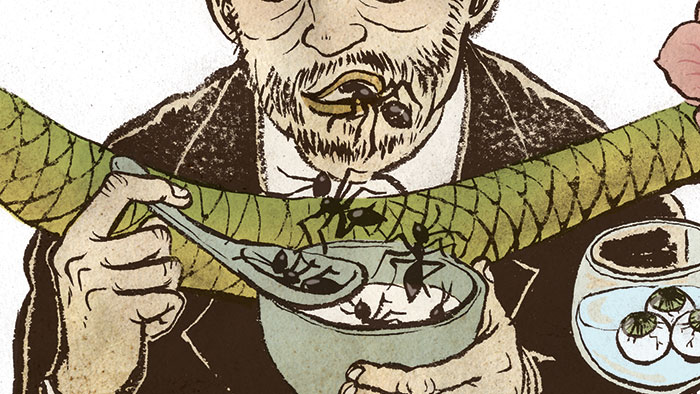
The doorbell rings and New Jersey’s Gene Rurka, a lean and hyper-kinetic fifty-eight-year-old, charges past the stacked boxes of dried scorpions on the kitchen floor, past the countertop terrarium with its thumb-sized Madagascar hissing cockroaches fattening on apple slices, past the stuffed coyote that guards the front hall, and exchanges a few pleasantries with the ups delivery man before returning with a Styrofoam container labelled “Annelids and Nematodes.” “The worms. Gotta have the worms,” he announces as he begins slicing open the package with a utility knife. “And scorpions. Rattlesnakes. Cockroaches. People’ll be pissed if I don’t have them.” He dredges up a snarl of writhing, foot-long earthworms and offers me a handful.
It is D-Day minus two for the man dubbed the King of Weirdness, and the deadline is pushing Rurka’s natural excitability toward irritation. The universe is not unfolding as it should. In two days, 1,300 people—members of the fabled Explorers Club and their guests—will gather in Manhattan’s Waldorf-Astoria Hotel for the group’s annual black-tie dinner, and Rurka, who is responsible for the exotic hors d’oeuvres, is determined to provide an experience unlike any in culinary history. Rurka scans the handwritten list on his kitchen counter: the beavers lie frozen in his Igloo coolers. Ditto the goat testicles, the shanks of kangaroo, and the shrink-wrapped bags of skinned Texas rattlesnakes. He’s had to pass on the yak and the llama, which, at $15 to $20 (US) a pound, would have blown his $25,000 budget. Nor could he locate any good, farm-fresh southern raccoons. But what is holding up the maggots? And where are the edible Hawaiian orchids The zucchini flowers? The damn tarantulas?
For over a century, the Explorers Club dinner has featured food meant to celebrate the things adventurers confront—or are forced in extremis to eat—at the world’s frontiers. In 1904, the menu listed roast polar bear; in 1978, elephant stew; and in 1987, freeze-dried astronaut ice cream, straight from the tube. But the fear of becoming a twenty-first-century anachronism recently propelled the group’s president, forty-six-year-old Richard Wiese, to throw caution to the wind. He’d learned from experience that the club could bring in a Sir Edmund Hillary or a Buzz Aldrin as keynote speaker only to have the New York Times report on the unusual cuisine at the dinner. So he asked Rurka “to go crazy” and seek out the strangest comestibles the planet has to offer. There were to be no endangered species. That meant no more elephant, blue-whale steaks, or paddlefish filets. And nothing that might offend political or personal sensitivities, which meant no domesticated dog or peacock or seal flippers. (In 1984, Prince Philip resigned his Explorers Club membership over the exotic hors d’oeuvres.) But insects, spiders, snakes, flowers, raccoons, pickled duck tongues, South American rats—these were another matter entirely. No one would feel sorry for a few hundred dead tarantulas.
Rurka, a farmer by profession and big-game hunter by avocation, was happy to help out. He loved food. He’d try anything. Most importantly, he had an inclination toward the comically macabre. In recent years—he’s been “exotics chairman” since 2002—Rurka had arranged the roasted crickets to appear as if they were crawling out of the herbed cream-cheese toastettes. He’d draped poached earthworms on the bare branches of a decorative tree, which looked, he now laughingly admits, as if someone had just sneezed.
In the back of Rurka’s Chevy Suburban is almost half a ton of food destined for the Waldorf-Astoria’s kitchen, where some of the gamier meat, like beaver, will marinate for thirty-six hours while other exotic items undergo final recipe-testing. It’s important to Rurka that no one equate the dinner with something out of Fear Factor. Instead, it’s meant to provide the guests, who pay up to $1,000 per person, with a lighthearted interpretation of what human hunter-gatherers may encounter. It’s survivalist make-believe on a porcelain plate. Each year Rurka tries to add something new and bizarre to the menu. There were rattlesnakes in 2002, worms in 2004, and—if they ever arrive—there’ll be maggots this time.
There’s a real logistical challenge to this enterprise, Rurka explains, and that is to collect the food from far-flung sources and know for certain that it has been raised to exacting health standards. Over the years, he has accumulated more than a dozen American suppliers and many more contacts. He grows circumspect when pushed for the business details of the exotic buffet, partly to protect his sources so others don’t try to duplicate the event and partly to protect his suppliers from animal-rights activists. Another consideration is the club’s experiment with franchising, in alliance with California’s Redwood Creek Wines, its exotic tasting: Pair scorpions on herbed-cheese endives with the 2002 Sauvignon Blanc! Try sautéed rosemary rattlesnake with the 2003 Chardonnay!
Rurka eventually confesses that the feral hogs, which are, at the moment, stacked in the back of the Suburban, come from a private game farm in Texas. A New York state trapper sent along the beavers, also frozen in back. From an alligator farm in Louisiana, from an Oregon earthworm breeder, from a Colombian ant exporter, the oddities have been sent, some packaged in steaming dry ice, others carried live to Rurka’s home in Somerset, New Jersey, by unsuspecting delivery men. And since Rurka’s developed an interest in entomophagy—the eating of insects—he has become familiar with breeders and pet-store suppliers. From them he buys $8,000 worth of scorpions, tarantulas, ants, crickets, cockroaches, and mealworms annually. The size of the specimens is crucial. A tiny tarantula doesn’t carry the same je ne sais quoi as a hairy, fist-sized beast served in a soy-tempura batter. And consistency of size ensures thorough cooking: Rurka doesn’t want a repeat of the 2001 fiasco, when a dozen guests, including his wife, Marianne, ate underdone tempura tarantulas and had to seek medical treatment when they reacted violently to the hairs on the spiders. (The New York Times ran a subsequent article titled “A Host’s Worst Nightmare: When Dinner Bites Back.” The club carries insurance to cover such embarrassments.)

The next day, seated in his trophy room in Somerset amid a dozen wall-mounted deer heads and another dozen stuffed birds, Rurka exudes relief. He has scrounged up eighty pounds of elk for a red-wine bourguignon, which will replace some of the other victuals that were too pricey to order. Moreover, his 740 organic edible rosebuds have arrived, as have the zucchini flowers and the tarantulas. And best of all, he says, is the fifteen pounds of dried fly maggots. Rurka and his wife have just spent two hours experimenting with ways to make them presentable. There are maggots on honey-glazed bananas, maggots in little phyllo triangles, and sautéed maggots in baked mushroom caps. I sample, and Rurka watches, relieved to see the maggots go down uneventfully. “Crunchy,” I report.
“I’ve had friends say, ‘I can get you maggots for free. I’ve got ’em under the mat in my car’s trunk,’ ” he tells me. “But I need clean maggots. Not from road kills or garbage. I’ve been working for a couple of years with an insect supplier. At first, he couldn’t believe I wanted “human-grade’ maggots. He thought I was nuts! I told him farmed maggots are raised on manure. They stink. I pay top price: $50 a pound. We’ve found a replacement substrate—“he pointedly refuses to name the material—” the maggots eat so they aren’t smelly. You can’t serve food that stinks or that’s repulsive. You don’t want to kill anyone.”
When I arrive at the Waldorf-Astoria’s vast kitchen on the morning of the dinner, more than twenty cooks are bouncing between workstations and stainless-steel trolleys as Rurka’s strange harvest is unloaded from the walk-in refrigerators. Rurka is bent over a colander, triple-rinsing a thousand earthworms to remove remnants of moss and cornmeal, their last gut-cleansing supper before they hit the grilling oven. From just behind him, Millie Lardizabal, one of the kitchen crew, offers one of her eighteen-day-old embryonic duck eggs, known as balut, and said, in her native Philippines, to have a Viagra-like effect. “Try it,” Rurka advises, then in a whisper adds, “but you might want to close your eyes.” Lardizabal removes the top portion of the shell, salts its contents, holds the egg to my mouth, and directs me to bite. I get a glimpse (which is quite enough) of embryonic duck. I bite blindly and chew fast. A slightly crunchy and feathery, coagulated, egg-tasting mush. When I open my eyes, Lardizabal is grinning. “Good? ” she asks. “Good,” I reply, weakly.
Just behind her is Sung-Cha Park, a respected Korean culinary artist. She can turn ordinary carrots into chrysanthemums and sculpt Buddha from a turnip. But the trayfuls of canapés she’s preparing would elicit screams at most gatherings. Her pièce de résistance is a half-dozen towers of vertically stacked pineapples, each crowned with a splay of leafy fronds to simulate a grove of miniature palm trees. To these she affixes with dagger-like ornamental toothpicks the five-centimetre-long hissing cockroaches, now dead—dispatched, in fact, by a spiced-brandy marinade. They are ugliness incarnate, with serrated legs and armoured exoskeletons. I know I’ll have to try one. But I’m in no hurry.
Rurka bounds from place to place, seeking advice from the crew. But there’s no doubt: he’s the one to whom everyone will turn on issues of taste. He sends the earthworms back for further tenderizing. He asks that the beer batter on the flowers be thinned so the tempura doesn’t conceal the colours and texture inside. He makes sure the tarantulas are cooked thoroughly. And when the first of the beavers makes its appearance, it is, after a day-and-a-half spent immersed in Cabernet, a cartoony purple colour, as if it has just escaped from Sesame Street. Rurka and banquet sous-chef Joshua Bierman discuss the beaver’s next culinary transformation, then Rurka turns his attention to the two feral hogs, which have just arrived on a pair of wheeled gurneys. Someone announces “It’s CSI time!” as half a dozen people transfer each pig to a prep table. Basted with a thyme, paprika, and chili sauce, upright ears protected from searing with comic, tinfoil dunce caps, mouths wedged open with skewers or empty cans, the hogs get departing kisses on the snouts from Bierman before the doors of the industrial ovens open and they begin their five-hour 350°F journey toward barbecued pork. “There weren’t nearly so many things before,” Bierman says of Rurka’s influence on the exotic buffet. “His message is: Don’t be afraid to try stuff. Don’t be afraid, period. That’s what exploration’s about.”
Late that afternoon, as darkness falls over Manhattan and the guests start arriving, Rurka’s collection—the rosemary-herbed rattlesnake cakes with sour cream, the lightly glazed edible orchids, the maggots in mushroom caps, the roasted South American ants on a seasoned crème fraîche cucumber boat, the beer-battered testicles served with chipotle aioli—ascends on freight elevators to the floor above. Not far away, the explorers themselves, decked out in dinner jackets and gowns worthy of an Academy Awards evening, ascend the ornate staircase toward the Grand Ballroom. I recognize Steve Fossett, who recently completed the first solo, nonstop, non-refuelling aerial circumnavigation of the globe, and Dr. James Watson, the Nobel Prize–winning co-discoverer of the structure of dna. Also in attendance, according to my program, are Col. Matthew Bogdanos, who led the US investigation into the 2003 looting of antiquities in Baghdad, and astronaut Dr. Kathryn Sullivan. The crush of elegant people grows, and I have a sense of what it might have been like during final decadent days of Caligula and his Roman friends, what with the trays of beaver (buckteeth and all) and braised legs of kangaroo moving through the crowd. Guests push toward the buffet tables—goading, tentative, wisecracking—reading the descriptions beside each dish then gradually sampling the palatable and the improbable. There is a lot of laughter.
The first plate I encounter is covered with five-centimetre-long roasted scorpions on durian- and foie gras-topped raisin bread. Scorpions are normally best dispatched with the sole of a boot and durian is, smell-wise, right up there with week-old road kill, but duty compels me to eat (very quickly) the offering. I see the skeptical look of the woman beside me. “Crispy,” I reassure her with a thin smile. The barbecued hogs have baked apples in their mouths. And Rurka has posed the toothy alligators as if they’re about to launch themselves at eaters’ throats. I ask the server for a slice. It has the chewiness of a chicken that has crossed the road once too often. With the throng pressing in, CNN cameras prowling, and celebrities milling about, I decide: What the hell! Carpe diem. I’ll try everything.
Moments later, however, I want to recant my pledge. A woman holds a skewered tarantula, honey-glazed and nearly the size of my hand. We speculate on its poison potential, then decide to stare arachnophobia in the face and share the spider. Within kissing distance of one another, we each gnaw off a hairy leg, giggling at the absurdity of the situation. Tarantulas have an astringent taste, like old Brazil nuts. But most buggy creatures are merely crunchy and head stomachward easily. My subsequent foray into worm cuisine, however, reaffirms that things wiggly and limp are best left to robins.
I seek comfort at the buffet table, filling my plate with seemingly safe, non-insect, non-wormy items. The elk bourguignon is five-star; the rosebuds in champagne batter and orange-honey sauce pure manna; the rattlesnake bony, but no problemo. There is, however, one item on my plate I keep avoiding. But duty calls, so I sink my teeth into the calf-eyeball fritter. Unless you’re a fan of the chewy-gelatinous—say, very old octopus Jell-O—certain textures can be a serious mouthful. The eyeball has the consistency of rubbery goo. My throat constricts. Digestively speaking, south suddenly begins heading north: a Noah’s Ark of invertebrates, reptiles, mammals, and worms is about to go airborne. Infamy looms. My rented tuxedo is about to be fouled. I fight the spasm. Willpower defeats reflexes. Then I look down. My bite has removed only the batter and there on my plate, staring up accusingly at me, is a half-eaten brown eye. South heads north again. Cheeks balloon. Please, God. Please! I will go to church if you make this stop. God listens.
Rurka moves anonymously through the gathering with an expression suggesting he can’t shake the lingering worries that come from masterminding such an event. “No poisonings? ” I ask him. “No. No screaming yet.” Ahead I see Park’s cockroach-covered pineapple palm trees and know that a moment of truth is at hand, here among the cognoscenti and the explorers. Do I have the Right Stuff? The cockroach is, on close inspection, hideous, fat, and shiny, with long, pointy feelers. And way too many legs. It’s something only Kafka could love. It would be ostracized in hell. I close my eyes and reassure myself with this fabled truth, the essential explorer’s dictum: no guts; no glory.




